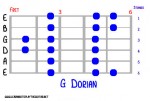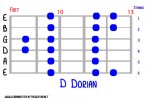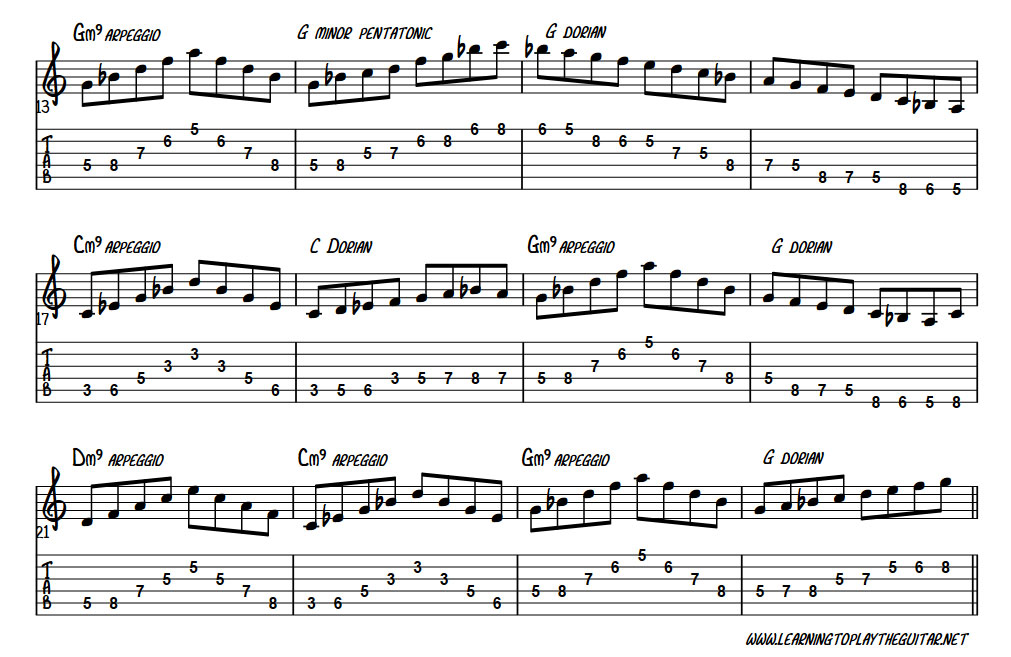Are you looking to break out a minor pentatonic scale rut on the guitar? Sick of playing the same old tired blues licks? Then this guitar lesson is for you! Here you will learn how to use modes and arpeggios to ground break your guitar soloing into new territory.
Modes
Modes are simply the notes of a scale starting at a different point. For example if you play the C major scale starting and ending on the D note you have played what is called the Dorian mode. The Dorian is a “mode of the major scale” that works well in songs in the key of D minor. A great example of this is So What by Miles Davis.
For more info on modes check out Solving The Mystery of Modes.
 For the G minor blues example used here we are going to play the G Dorian mode over the G minor chord in song. The G Dorian mode works well as it contains the note of the G minor chord (G, Bb, and D). The main pattern for the Dorian mode on the guitar is similar to the minor pentatonic scale with 2 extra notes added (for G Dorian A and E)
For the G minor blues example used here we are going to play the G Dorian mode over the G minor chord in song. The G Dorian mode works well as it contains the note of the G minor chord (G, Bb, and D). The main pattern for the Dorian mode on the guitar is similar to the minor pentatonic scale with 2 extra notes added (for G Dorian A and E)
T o make things more interesting when the song changes to the other chord we will play a different mode. For the C minor chord we will play the C Dorian mode as it contains the note of the C minor chord (C, Eb, and G).
o make things more interesting when the song changes to the other chord we will play a different mode. For the C minor chord we will play the C Dorian mode as it contains the note of the C minor chord (C, Eb, and G).
While fo r the D minor chord we will play the D Dorian mode as it contains the note of the D minor chord (D, F, and A).
r the D minor chord we will play the D Dorian mode as it contains the note of the D minor chord (D, F, and A).
However to play a guitar solo using the 3 main patterns for each mode will result in it sounding disconnected and mechanical between each chord change. To prevent this the modes can be played in the closer and overlapping positions on the guitar neck.
9th Chord Arpeggios
The next element to be added to the guitar solo will be the use of 9th chord arpeggios giving it a jazzy sound. A 9th chord is a 7th chord with an extra note added which is the 9th note from the root note. For example the G minor 9 chord uses the notes G Bb D F and A. These are the 1st, 3rd, 5th, 7th and 9th notes in the G minor scale.
In the following example the G minor 9, C minor 9 and D minor 9 arpeggios will be used with the G and C Dorian modes. This exercise can be used to practice playing arpeggio patterns and modes over a G minor blues.
Listen to the audio of G Minor Blues Arpeggios & Modes. |
While the previous example was a great exercise it is rhythmically too rigid (using just 8th notes) to be a truly expressive guitar solo. The solo example below uses the arpeggios and modes but also includes phrasing by playing longer and shorter notes to create a more melodic solo.
Also note that the arpeggios don’t necessarily use all the notes of the 9th chords nor do they even start on the root note. (e.g. G for G minor 9). This helps to create interest in the solo and prevents it from becoming predictable. Finally note how guitar techniques such as bends, hammer-ons, pull-offs and slides are used to create expression in the solo.
| G Minor Blues Solo | Download Listen to the audio of G Minor Blues Solo. |
Once you get this solo under your fingers and the ground breaking concepts of modes and arpeggios shown in this guitar lesson try and see how you can apply them to solos in other songs you play.






